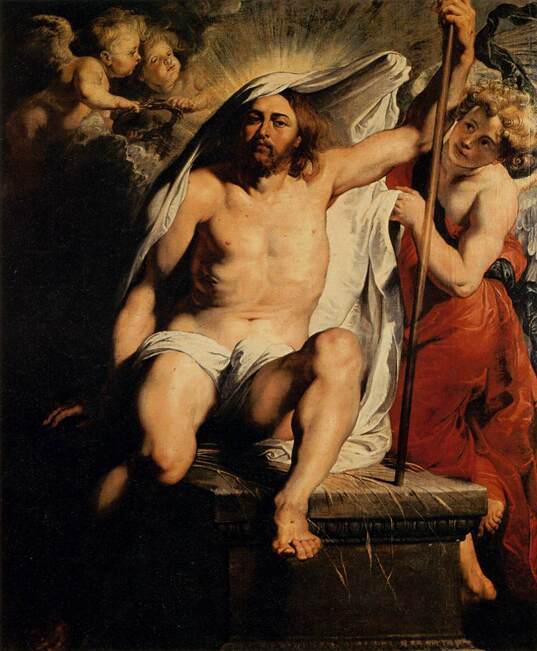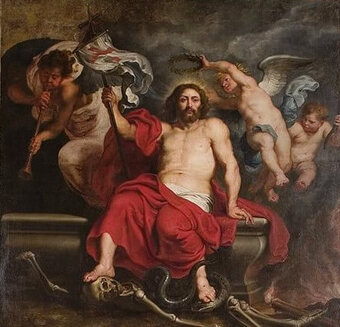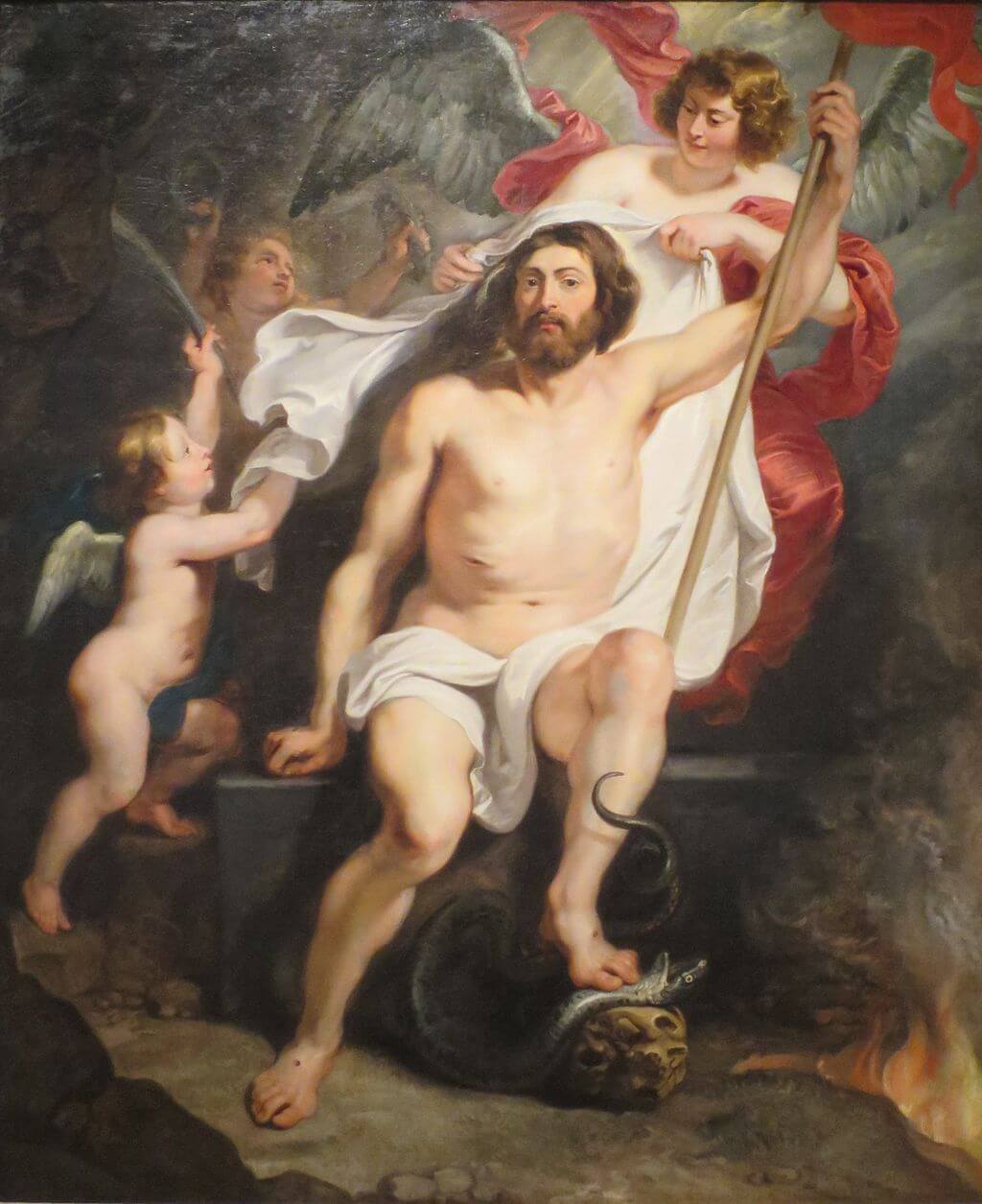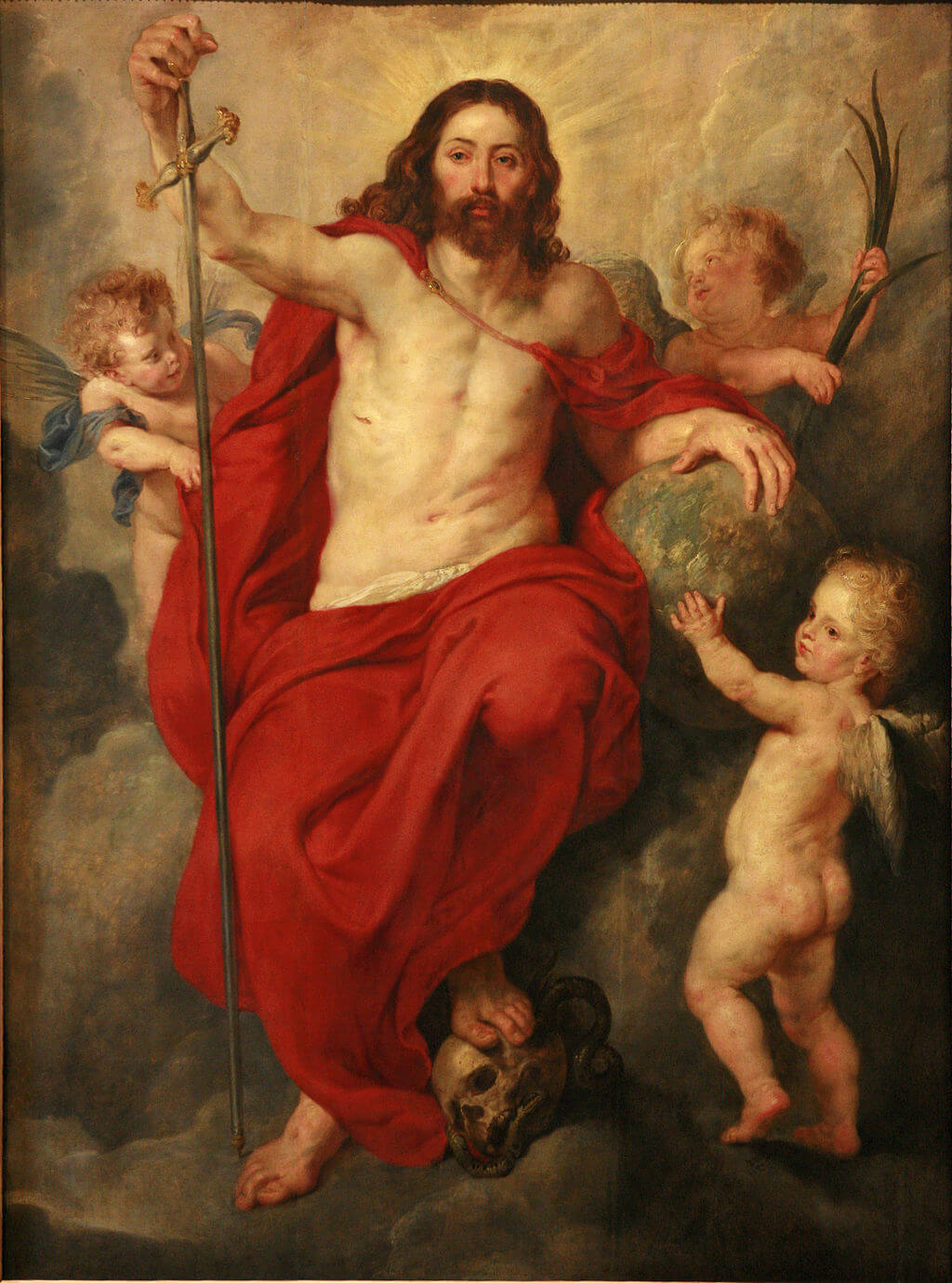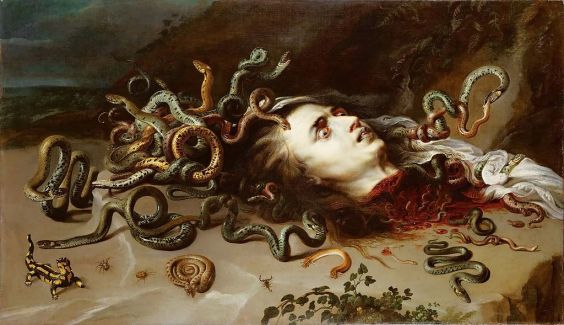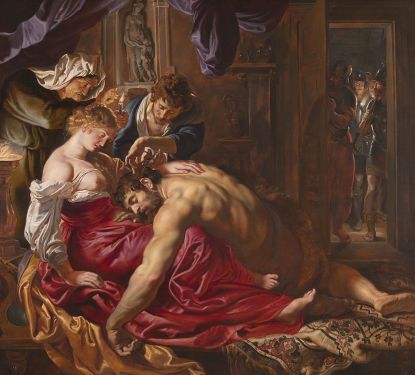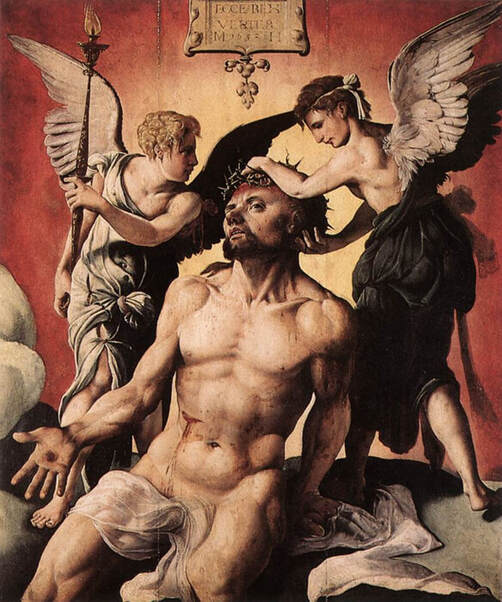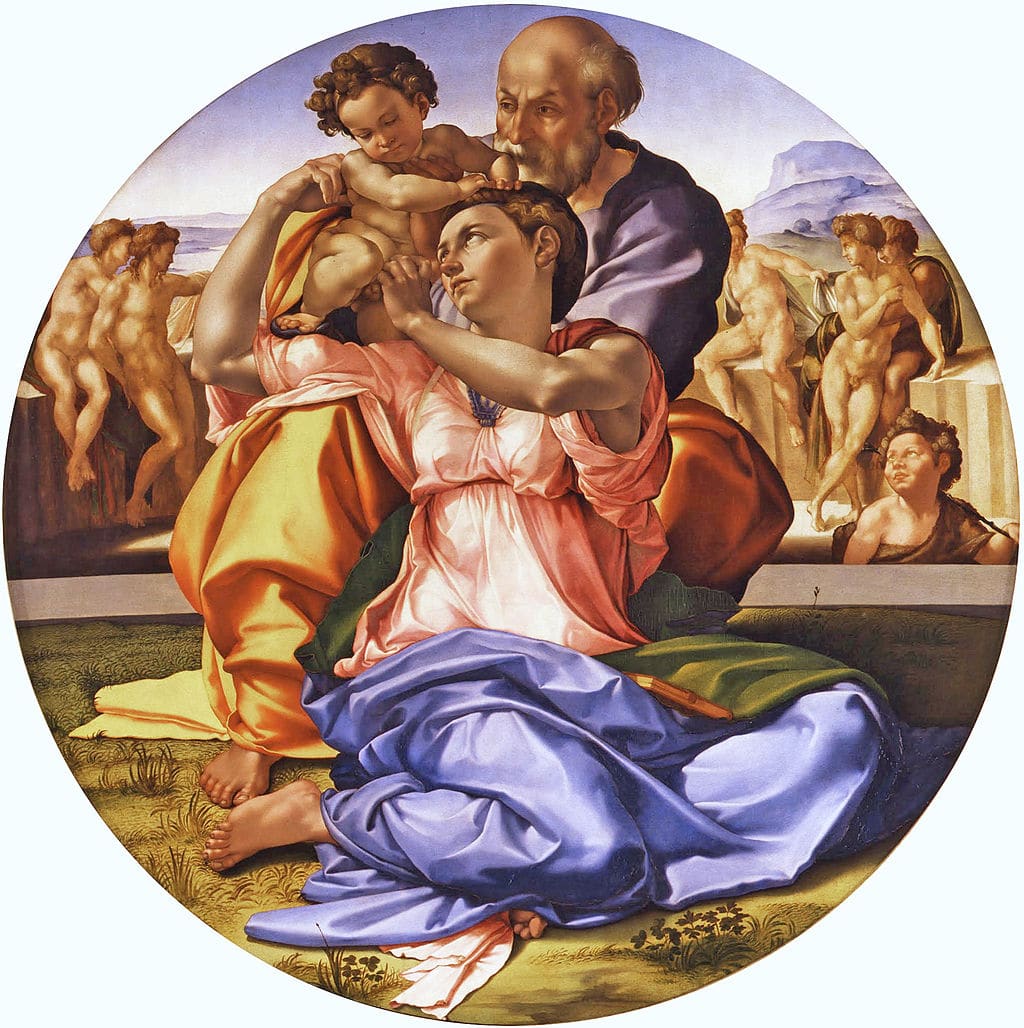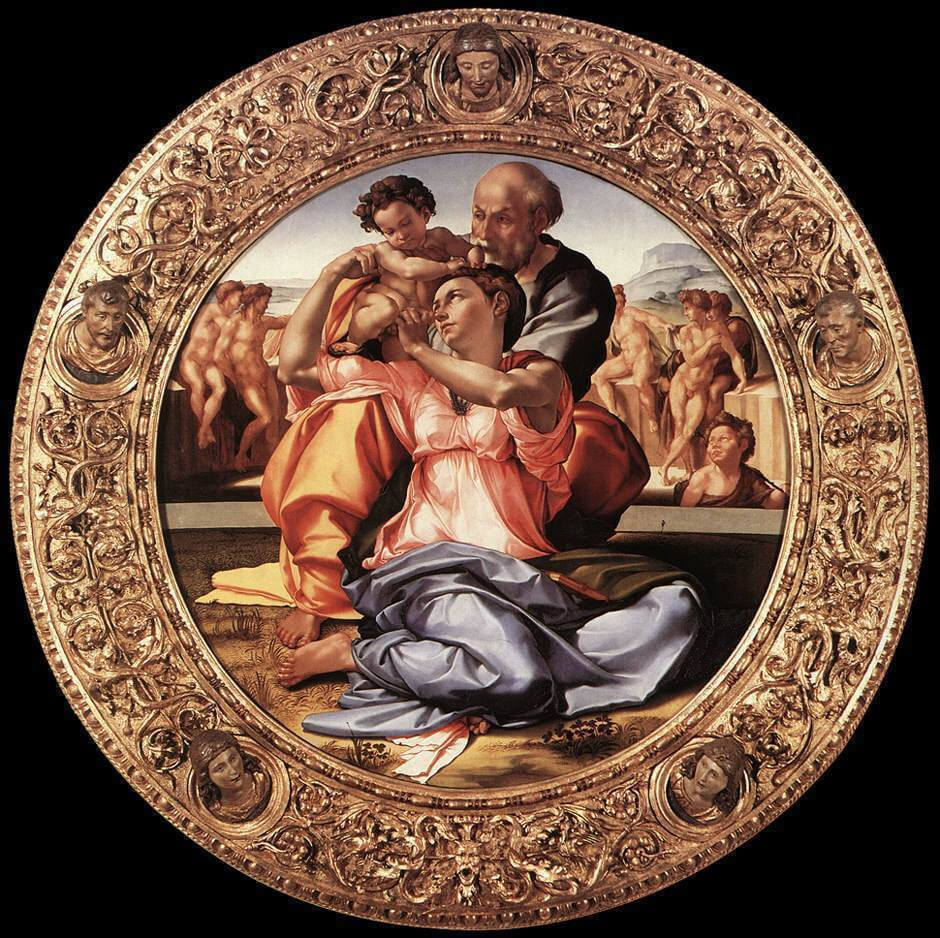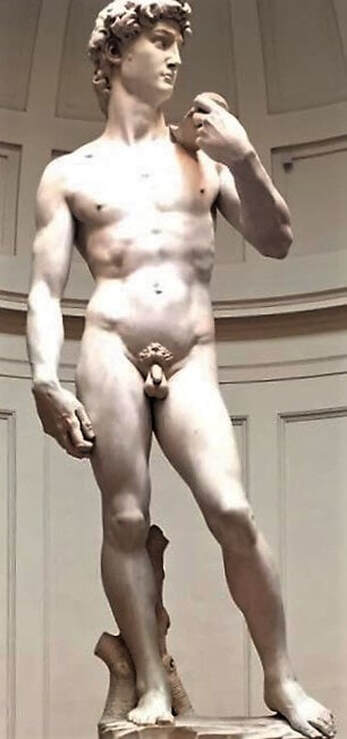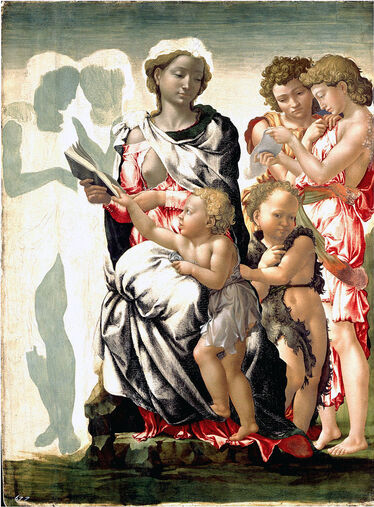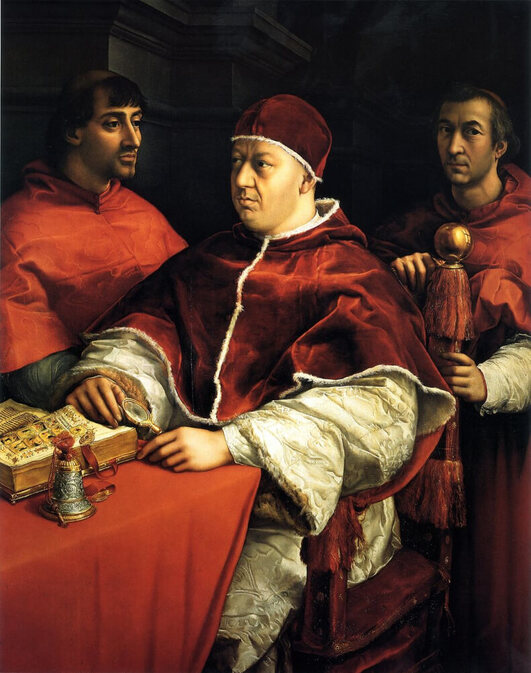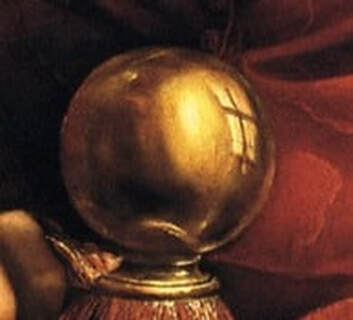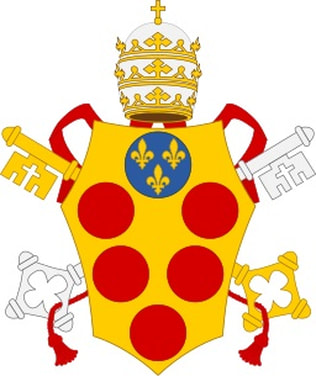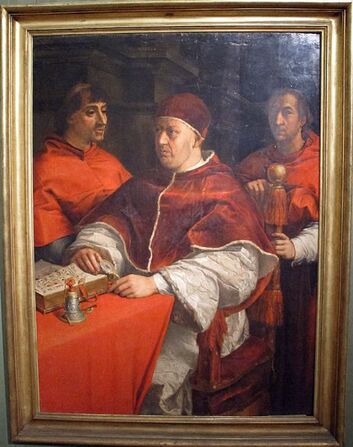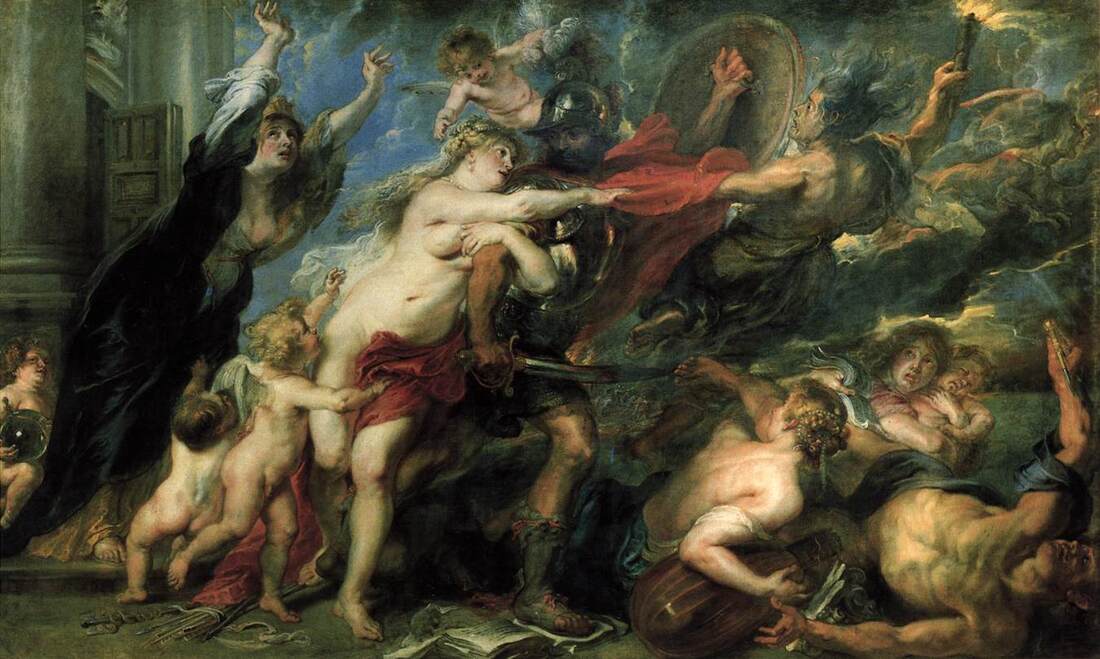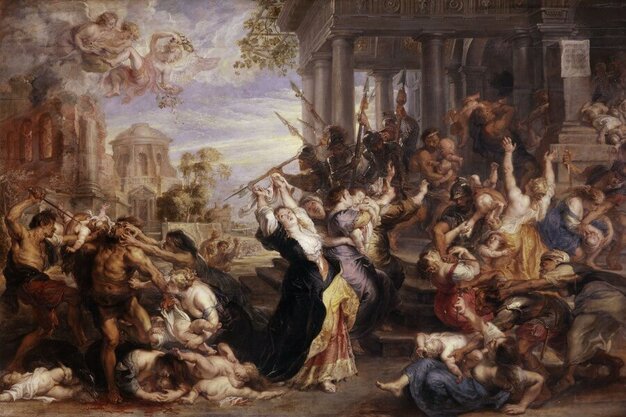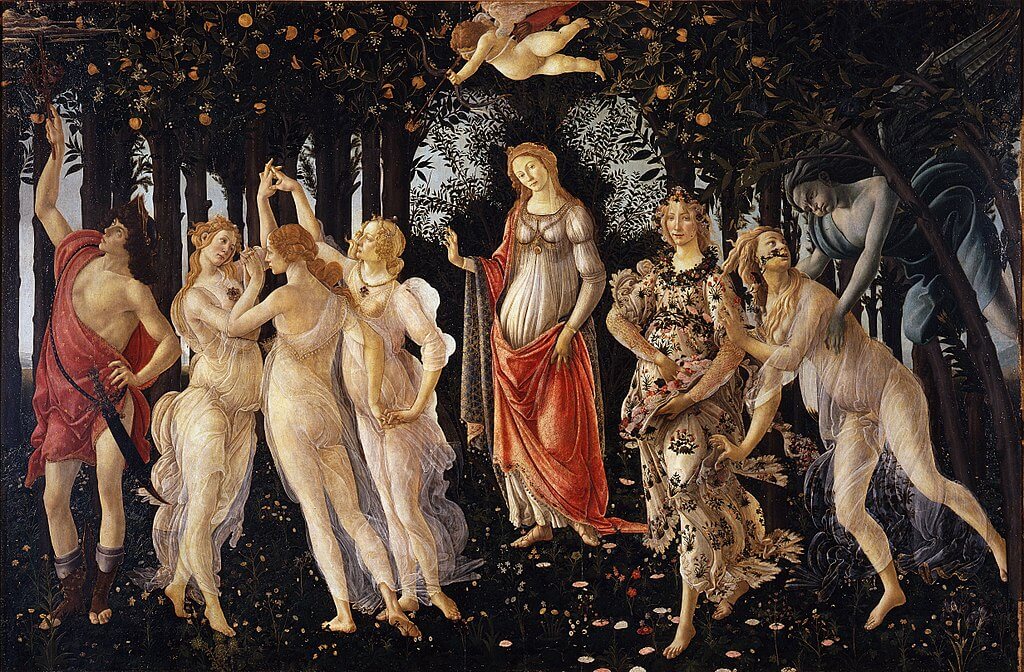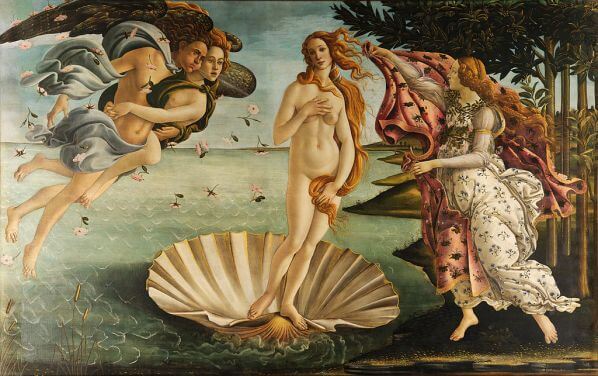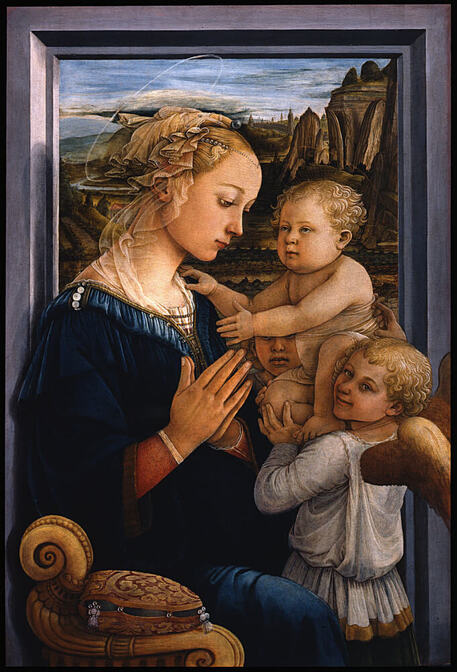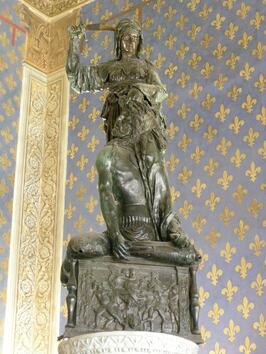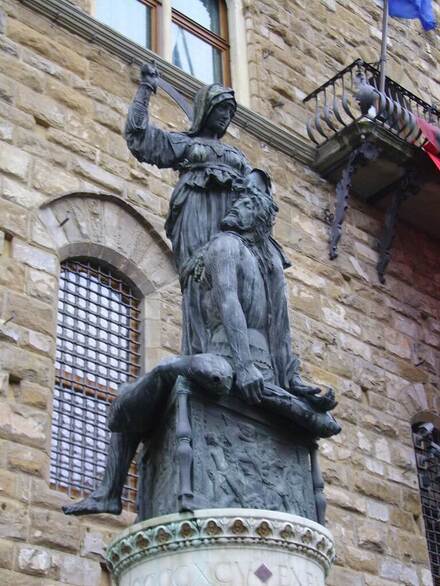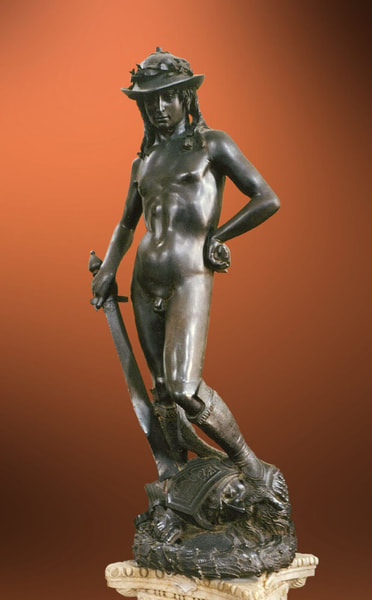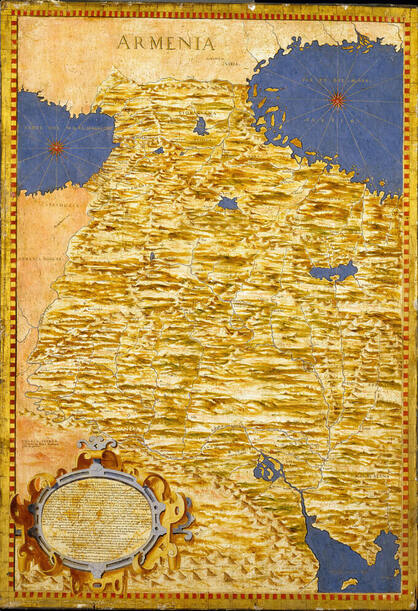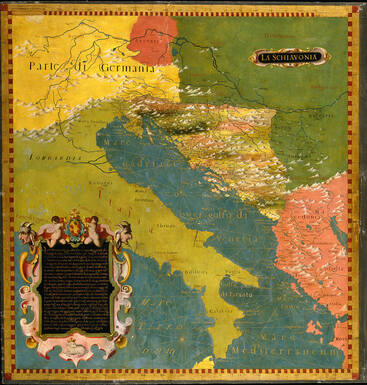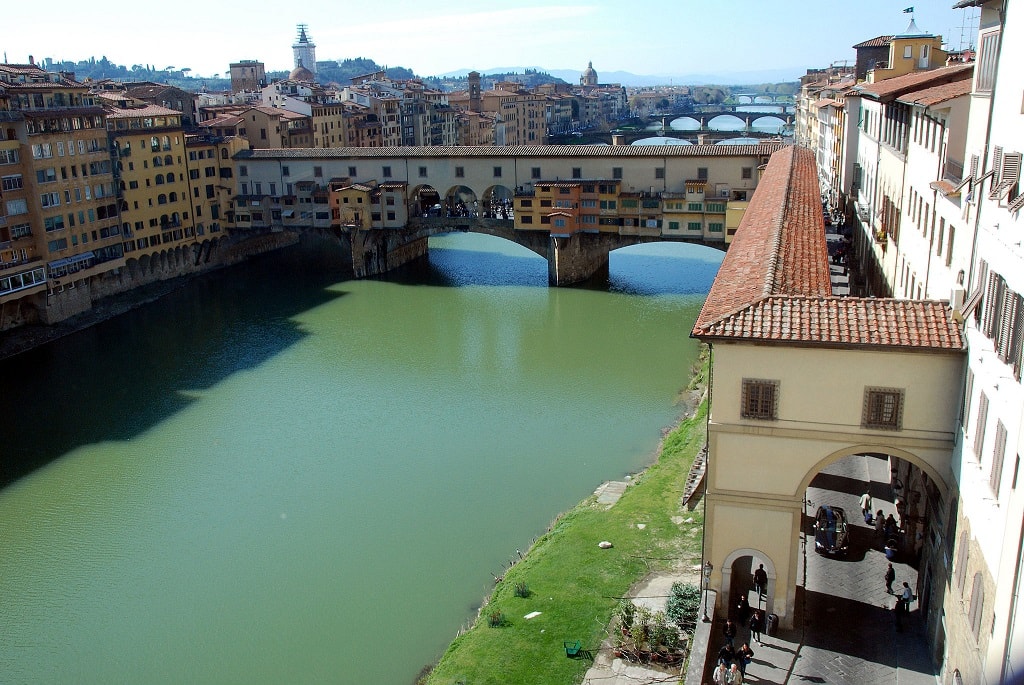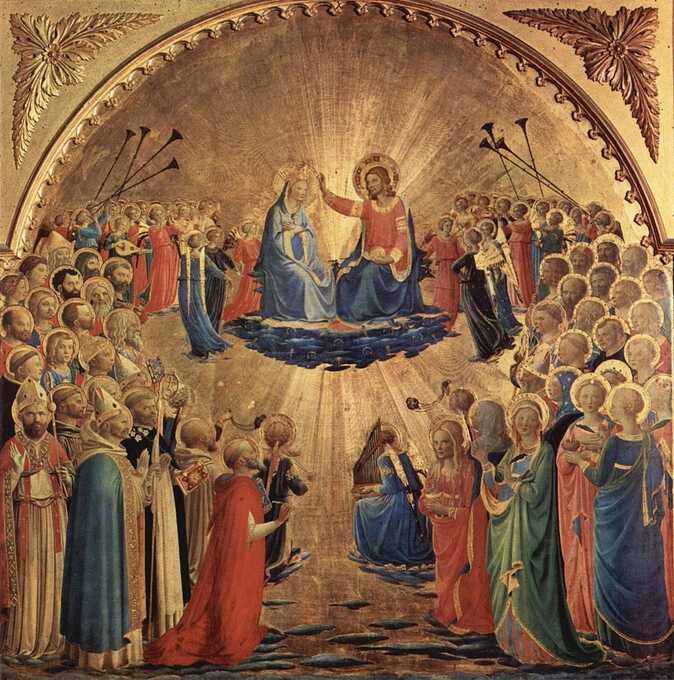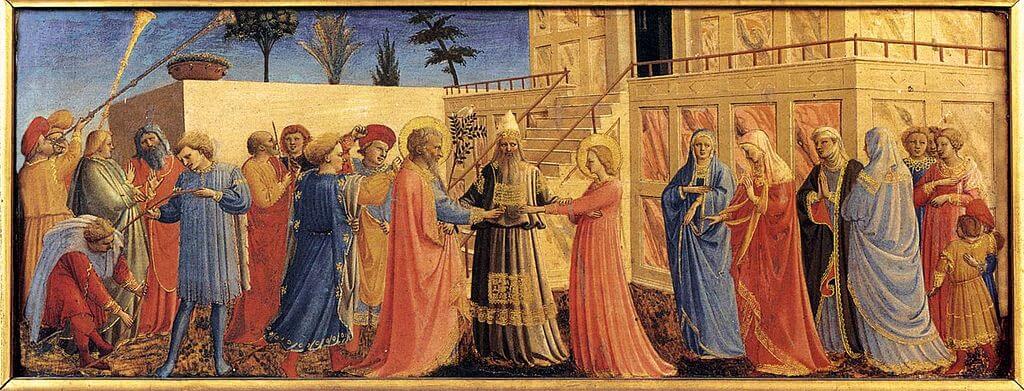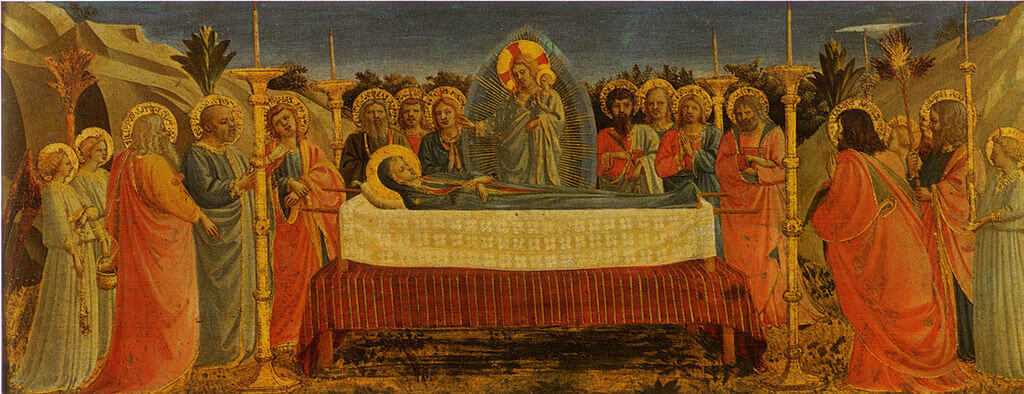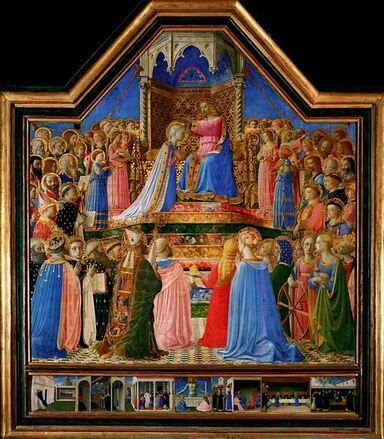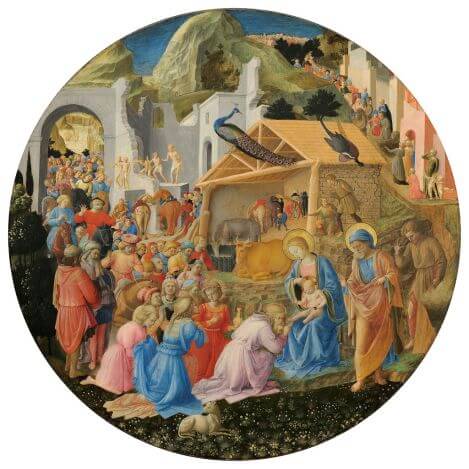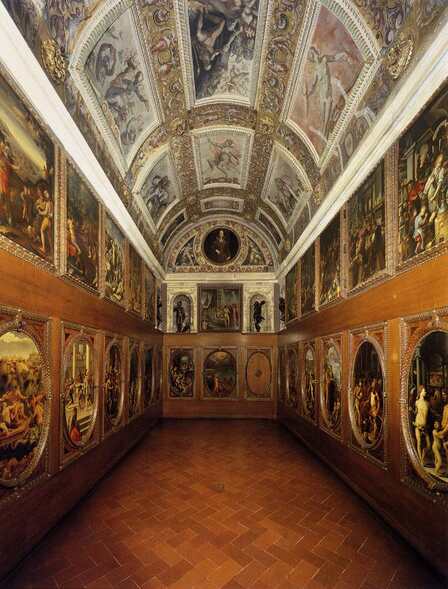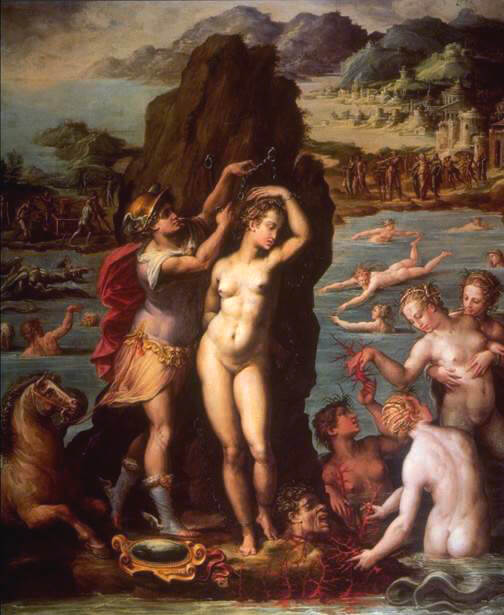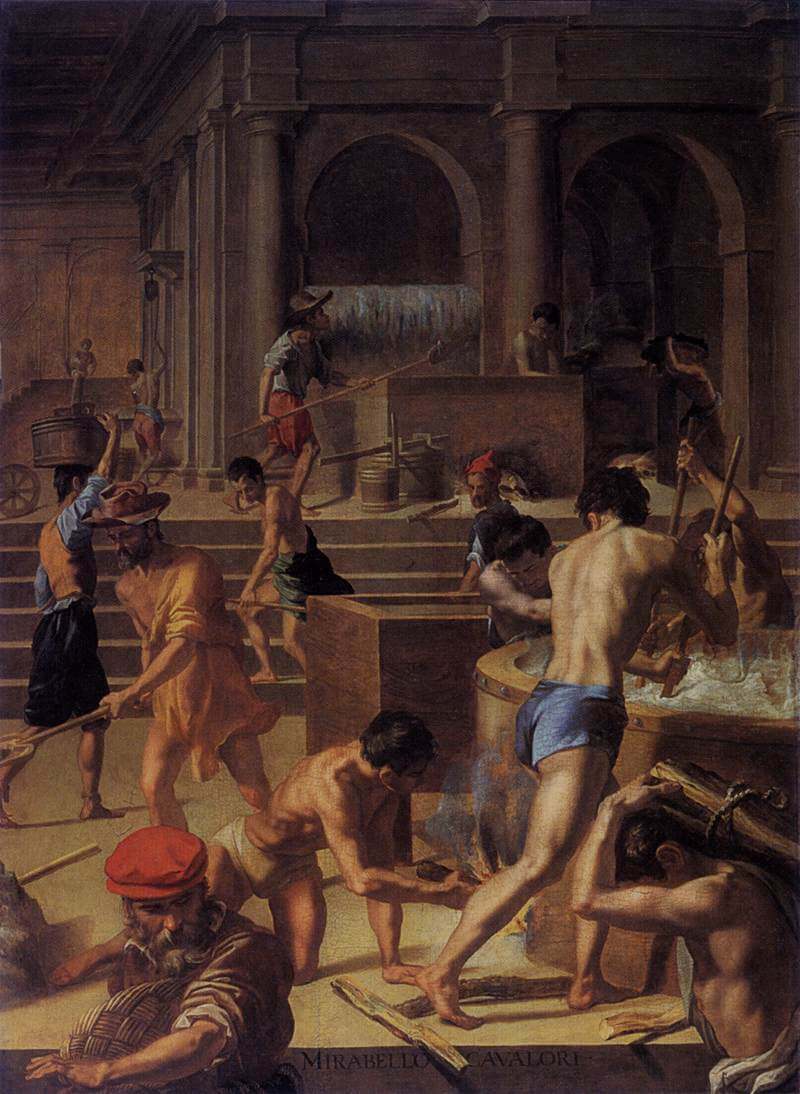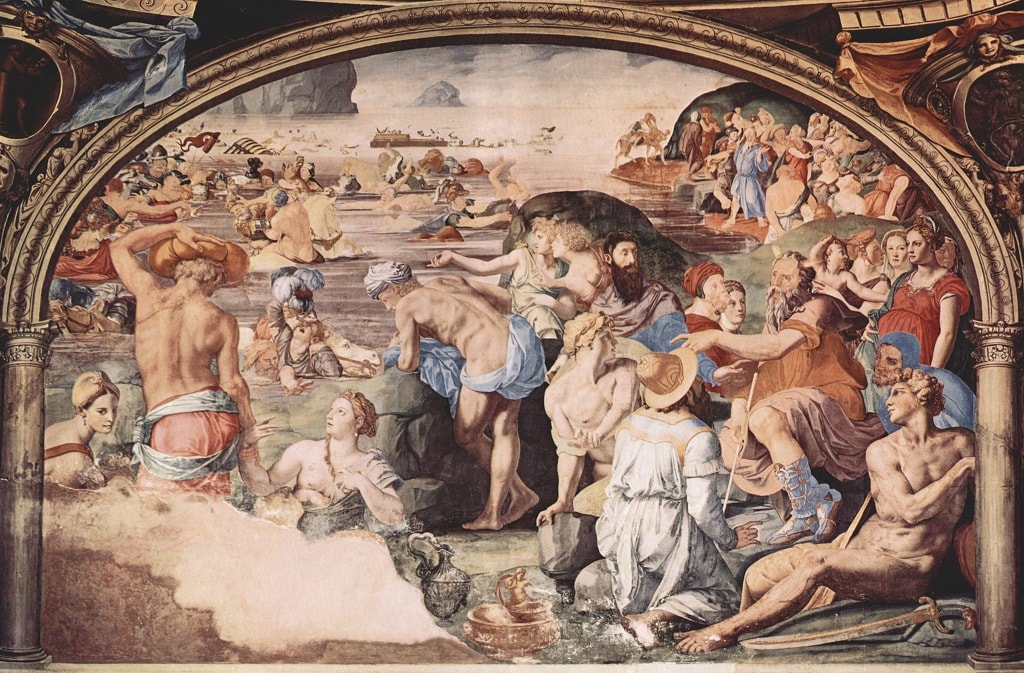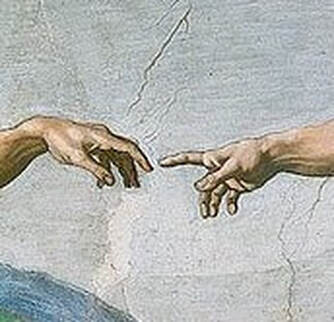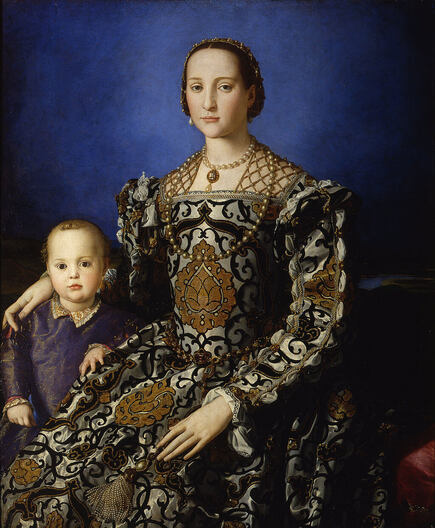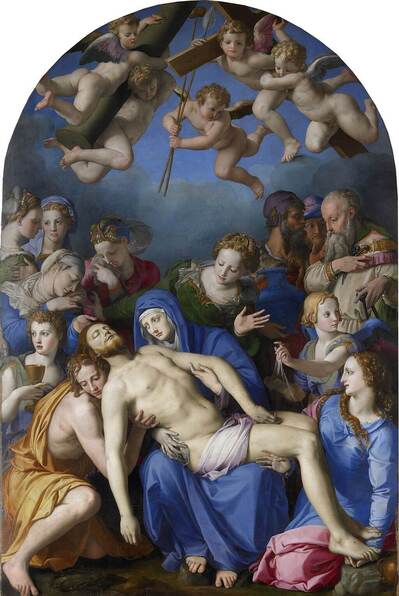|
Where? Palatine Gallery in the Palazzo Pitti
When? 1616 What do you see? Jesus is shown just after he has risen from his grave. On top of his head are bright rays of light shine to indicate his holiness. Light shines brightly on most parts of his body to emphasize that Jesus is alive again. You can still some remains of the wounds that he suffered during the crucifixion (see the middle of his left foot and arm, and the wound, partly in the shadow, on his right side which was pierced by a lance).
On the top left, two small angels are waiting to put the crown of thorns on Jesus (some people say that they took this crown from Jesus, but the head of Jesus is still covered). The large angel on the left, dressed in orange, lifts the cloth in which a dead person is wrapped for burial (also called a shroud). You can imagine that the right hand of this angel is behind the top right of the cloth. On top of the tomb are pieces of wheat that symbolize the bread used in the Holy Communion, which in turn symbolizes the body of Jesus.
Backstory: This painting by Rubens is known under various names, such as ‘The Easter Tomb,’ ‘Christ Resurrected,’ ‘The Resurrection of Christ,’ ‘The Triumph of Christ over Death and Sin,’ and ‘Resurrected Christ Triumphant.’ The reason for some of these alternative names is that Rubens created several other paintings based on this original version. In several of these versions, there is a skull and a snake under the feet of Jesus, which is why some people have also started to refer to the original of Rubens as the triumph over death and sin. One of these later versions is in the Columbus Museum of Art in Columbus, Ohio, another one in the Musée des Beaux-Arts in Strasbourg, France, and other versions are, among others, in Vienna (see above) and in a private collection. Ferdinando de’ Medici, Grand Prince of Tuscany, acquired this painting in 1713, and it entered the collection of the Palazzo Pitti in 1723.
Why the Resurrection? Three days after Jesus is crucified, he rises from the dead. That Jesus died for the sins of humanity and that he rose from his grave are both predicted by the Old Testament and central to Christian faith. The Resurrection is celebrated every year at Easter Sunday. Because of its central importance in Christian faith, it is not surprising that people wanted to have paintings to remind them of such a pivotal moment in the Bible.
The Resurrection was also, more than once, used as the topic for a painting next to a tombstone in a church, to remind the mourners that this person would one day come back to life again (on the day of the Last Judgment). Who is Rubens? Peter Paul Rubens (1577-1640) was one of the most important painters of the Baroque period. Rubens was well-educated and spend eight years in Italy during his twenties, where he got inspiration from great Italian painters, including Caravaggio, Michelangelo, Raphael, Titian, and Veronese. After Rubens came back from Italy, he became the court painter in the Low Countries and based his studio with many assistants in Antwerp, Belgium. He painted many mythological and biblical themes. One great example of a mythological work is his Head of Medusa in the Kunsthistorisches Museum in Vienna. A wonderful example of a biblical work is Samson and Delilah in the National Gallery in London.
Fun fact: Many people have asked themselves whether Jesus has an erection in this painting or whether it is just a ‘random’ fold of the sheet around him. It is not unlikely that Jesus has an erection in this painting as this was something that was not that uncommon in depictions of Jesus in the Northern Renaissance.
Sexuality was considered a normal human trait in the 16th and 17th century and also something that Jesus would have experienced. Showing the erection was a way of communicating that Jesus was really a man that walked around on Earth. While in this painting, the erection is not that explicit, it is a bit clearer in a painting from Maarten van Heemskerck.
0 Comments
Where? Room 41 of the Uffizi Museum
When? 1506-1508 Commissioned by? Agnolo Doni to celebrate his marriage with Maddelena Strozzi (from the powerful Strozzi family). What do you see? Mary, Joseph, and Baby Jesus are shown in the center. Mary is sitting on her knees and looks up to Jesus while handing Jesus to Joseph. On the right, a young John the Baptist is depicted and in the background a group of five young and naked people. Look at the body of Mary, which is partly turned around in a somewhat unnatural pose. This painting has been influential for future work and has been labeled as one of the foundations of Mannerism, which is an art style in which ideas such as proportions, balance, and ideal beauty are violated on purpose. Look also at the frame, which contains five carved heads. The head of Jesus is on top, and the other four heads represent the four prophets that told about the coming of the Messiah. This painting stands out because of its bright colors, which are due to the tempera pigment used by Michelangelo. This pigment typically keeps its color over time.
John the Baptist (the patron saint of Florence) is strategically posed in between the Holy Family and the pagan people in the background to bridge the gap between both worlds.
In front of John the Baptist, there is a plant that is a combination of a hyssop (a symbol of the humility of Christ and baptism) and a cornflower (a symbol of Christ symbolizing heaven). The clover in the foreground represents the Trinity (God, Jesus, and the Holy Spirit). The carvings on the frame include crescent moons, lion heads, stars, and vegetation, and are believed to refer to the Doni and Strozzi families. Who is Doni Tondo? Agnolo Doni was a wealthy Florentine banker. The word ‘tondo’ was used to refer to a circular work of art. Tondo is derived from the Italian word ‘rotondo’, which means round. The term ‘tondo’ is typically only used for large round paintings (over two feet in diameter). Why the Holy Family? The Holy Family is a model for Christian families. The Holy Family is depicted in two different ways. Most commonly, it consists of Jesus of Nazareth, his mother, the Virgin Mary, and his foster father, Saint Joseph. However, there are also other versions in which Saint Joseph is replaced by Saint Anne, the mother of Mary. Who is Michelangelo? Michelangelo di Lodovico Buonarroti Simoni (1475-1564) was an architect, engineer, painter, poet, and sculptor. He is considered to be one of the greatest artists ever and was considered the best artist of his time. He is probably most well-known for his sculptures (think about the David and the Pietà) and his frescos at the Sistine Chapel. Fun fact: This is the only finished panel painting by Michelangelo that exists nowadays. In the National Gallery in London, there are two other panel paintings of Michelangelo, The Entombment and The Virgin and Child with Saint John and Angels, but he did not finish these paintings. Michelangelo was quite good in not finishing his work, as can be seen by the fascinating series of unfinished sculptures in the Galleria Accademia. Of course, Michelangelo has also painted frescos, like the famous ones in the Sistine Chapel. Interested in a copy for yourself? Poster or canvas.
Where? Room 41 of the Uffizi Museum
When? 1517-1519 Commissioned by? Pope Leo X What do you see? The portrait of Pope Leo X, shows the Pope sitting in his study. He is depicted realistically in a three-quarter profile. He wears the papal robe and the papal camauro, a cap traditionally worn by the pope. A cardinal is on both sides of him. Their silence helps to establish the authority of Pope Leo X in this painting. All three are wearing velvet (a woven fabric with evenly distributed patterns), and the Pope is also wearing a so-called, damask undergarment that shines in the light and has fur linings.
Backstory: Raphael was the lead painter for Pope Leo X and he had already made quite some portraits of Pope Leo X in fresco scenes. He also painted several portraits of Leo X to distribute throughout Italy. The current painting is the most well-known of these different portraits. The idea behind distributing these paintings was to promote the Medici regime throughout the country. This was important as a lot of things were happening in those years that created uncertainty for the common people and their leaders. One of these things was that Martin Luther (a famous German theology professor) publicized his famous list of complaints against the Roman Catholic Church.
Between 1513 and 1605, four popes came from the Medici family. An important reason for this is that popes liked to appoint their family members as cardinals, making it more likely that they would eventually become pope. The cardinal on the left of the painting is Giulio di Giuliano de’ Medici (a cousin of the Pope who would become Pope Clement VII from 1523 until 1534). The cardinal on the right is Luigi de’ Rossi (another cousin of the Pope).
Who is Pope Leo X? Giovanni de’ Medici (1475 – 1521) is the second son of Lorenzo the Magnificent, the ruler of the Florentine Republic. He became a cardinal at 13 years old. An important reason that Giovanni became a cardinal at such a young age was that his sister was married to Pope Innocent VIII. He became pope on March 9, 1513, until his death on December 1, 1521.
During his rule as pope, Leo X excommunicated Martin Luther from the church, and he granted people who donated to the reconstruction of St. Peter’s Basilica a reduction in the amount of punishment they would have to undergo for their sins (called indulgence). He was a big spender and ruined the papal finances under the motto: “Since God has given us the papacy, let us enjoy it”. Who is Raphael? Raffaello Sanzio da Urbino (1483-1520), popularly known as Raphael, was born in Urbino, a small city a few hours east of Florence. His father, Giovanni Santi, was a painter with a good reputation, but Raphael had already lost both his parents at age 11. Raphael is best known for his depictions of the Virgin Mary (Madonnas), and his large-scale depictions of humans. His work is widely appreciated for the clarity and magnificence with which he could paint people and his simple compositions. In 1508, he was summoned to Rome by Pope Julius II, the predecessor of Pope Leo X, to become the lead court painter. He stayed there until his death, which was one year before the death of Pope Leo X. He is buried in the Pantheon in Rome.
Where? Room 26 in the Palatine Gallery in the Palazzo Pitti
When? 1638-1639 Commissioned by? Ferdinando II de’ Medici, the Grand Duke of Tuscany What do you see? In the middle of the painting, you see Mars (the god of war) with his armor, helmet, red cape, shield, and bloody sword. Mars is stepping on top of a book and a drawing. To the left of him, you can see Venus (the goddess of love) who clings to his arm. She tries to seduce him and to pull him back from the war. Venus is largely naked and has a red cloth between her legs. To her left and above her are two small Cupids with wings who try to help her. Below the standing Cupid, you can see some arrows, a caduceus, and an olive branch laying on the ground. To the right of Mars is Alecto, one of the Erinyes whose job it is to punish the moral crimes of humans. Alecto has a torch in one hand and is pulling the left arm of Mars to engage him in the war. To her right are two evil-looking figures that add to the aggressiveness of war in this painting. Below Alecto is the goddess Harmony holding a broken mandolin while being pushed to the ground. To her right is an architect laying on the ground holding a compass and some of his other tools have fallen. Above them are a mother and a child. On the left, you can see a despaired woman dressed in black with her arms up in the air. This woman represents Europe and you can also see her in the middle of Rubens’s earlier painting Massacre of the Innocents in the Alte Pinakothek in Munich. To the left of this woman is an angel holding a globe with a small cross on top of it. Above this angel is the Temple of Janus which is on the Roman Forum in Rome.
Backstory: Rubens received a commission for a painting for the Grand Duke of Tuscany through an intermediary in Florence called Justus Sustermans. Rubens was allowed to pick his own topic, and following his desire for peace, he proposed to create a painting on the consequences of war. He created a couple of sketches on his ideas for the painting which the Duke approved.
Rubens painted the work while he was in his studio in Antwerp. This painting is sometimes also referred to as the Horror(s) of War. The painting reflects Rubens’ views on how the Thirty Years’ War between 1618 and 1648 affected Europe. Symbolism: Venus, the goddess of love, tries to persuade Mars, the god of war, to end the violent war, but Mars is not listening. So, this painting symbolizes the victory of warfare over peace. The gloomy woman dressed in black, who is not wearing any jewelry, represents Europe, which has suffered from war, abuse, and looting during the Thirty Years’ War. The door of the Temple of Janus is open, which was only the case during wartime as the door was closed when there was peace. The globe with the cross on top of it represents the Christian world. The arrows, caduceus, and olive branch represent the absence of peace. In addition, there are also several symbols present to indicate the consequences of war. Specifically, war has bad consequences for life (indicated by the woman holding the baby), culture (indicated by Mars stepping on a book and a drawing), arts (indicated by Harmony being pushed to the ground while holding the broken mandolin), and crafts and architecture (indicated by the man on the right holding a compass. What is the Thirty Years’ War? This very complex war took place between 1618 and 1648 and involved the area which is currently Germany. Many different countries were involved at different stages of the war, including Austria, Denmark, England, France, Spain, and Sweden. There were a total of eight million casualties in this war. This war started as one between Catholic and Protestant areas in Europe but developed later into a war between some of the most powerful European countries. Who is Rubens? Peter Paul Rubens (1577-1640) was born near Cologne in Germany where his family was exiled. When Rubens was ten years old, his family returned to Antwerp where they were originally from. Antwerp was one of the bigger cities in Europe at that time. Rubens received a good education and traveled throughout Europe to learn about art. He spent several years in Italy and was impressed by the art that he saw in Florence, Rome, and Venice. He got inspired by artists such as Caravaggio, Michelangelo, Raphael, and Titian. For example, the Venus in this painting shows quite some similarities to the Venus as painted by Titian in the Venus of Urbino which is in the Uffizi Museum. At age 29, Rubens returned to Antwerp where he built a large Italian-style house which served as his house and his art studio. The house has survived and is now called the Rubenshuis and serves as a museum about Rubens.
Fun fact: Throughout his life, Rubens traveled all across Europe to complete different commissions. He was the court painter for several kings and queens. Rubens did not like war and was passionate about creating peace. So, during his trips through Europe and while visiting the leaders of several countries, he started to act as a peace negotiator between the different countries involved in war.
As an example, Rubens was very active as a diplomate between 1627 and 1630 trying to bring peace between England and Spain. However, he always combined his diplomatic trips with studying art in the different countries as he was first and foremost an artist.
Where? Room 10-14 of the Uffizi Museum
When? Between 1477 and 1482 Commissioned by? Lorenzo de’ Medici as a wedding gift to his cousin Lorenzo di Pierfrancesco de’ Medici What do you see? Eight figures in the meadow, surrounded by hundreds of different flowers. The blue figure on the right is Zephyr, the god of the west wind. Zephyr is chasing the nymph Chloris, who is associated with flowers and spring. Zephyr’s breath turns Chloris into the woman with the dress decorated with flowers (who is thought to be the goddess of Spring, called Flora). The central figure in the middle is Venus. To the left of Venus, the three Graces (Charites in Greek) are dancing. The Graces are minor deities in Greek mythology. To the left of the Graces is Mercury (Hermes in Greek), the messenger of the Greek gods, who is scattering the clouds with his staff. Some people say that Mercury may be modeled after Lorenzo de’ Medici who commissioned this painting. On top on Venus is Cupid (her son) aiming his flaming arrow at one of the Graces. Backstory: The painting only got his name, La Primavera in 1550 when Giorgio Vasari saw the painting, but it is also known as the Allegory of Spring ('primavera' is Italian for 'spring'). The painting is full of allegories (hidden meanings), which leads to much debate on how to interpret the painting. While many interpretations have been given, a popular interpretation is that the painting is inspired by a story from the poet Ovid. In his book Fasti (Amazon link to the book), the nymph Chloris is naked and attracts the first wind of the spring, which is represented by Zephyr. When Zephyr captures her, flowers sprang from her mouth and she turns into the goddess Flora. After Botticelli completed the painting, it was placed in the summerhouse of the Medici family, where it would hang next to The Birth of Venus which Botticelli completed a few years later.
Symbolism:
Who is Venus? Venus is the Roman goddess of love, beauty, sex, fertility, prosperity, and desire. Venus is also known in the Greek mythology as Aphrodite. Venus and Mars are the parents of Cupid. In art, Cupid is often depicted together with his mother, Venus. Why Venus? Nudity was the natural state of Venus, which provided a good excuse to include nudity in an artwork. This was an important reason for her popularity in Renaissance art. Whereas in this painting Venus is still dressed, this will quickly change. A few years later Botticelli painted The Birth of Venus in which she is already largely naked.
Who is Botticelli? Sandro Botticelli (1445-1510) was a painter who belonged to the Florentine school of painters. The name Botticelli means “little barrel”. He got this name because people described his brother as “fat like a barrel”. Botticelli was initially trained by his brother to become a goldsmith, but at the age of 14, he became an apprentice to the successful painter Filippo Lippi (1406-1469), known from the painting Madonna and Child with Two Angels. Later in his life, Botticelli became a mentor to both Leonardo da Vinci and Michelangelo.
Fun fact: The painting contains over 500 individual flowers and between 170 and 200 different varieties. Most of these flowers were growing in the spring around Florence. Botanical experts are already inspired for centuries by these flowers. They have been able to identify about 130 flowers, including daisies, forget-me-nots, jasmine, lilies, and violets. For the remaining flowers, there is quite some debate on whether these are fantasy flowers created by Botticelli or real flowers that existed in 15th century Florence but are now extinct.
Interested in a copy for yourself? Poster or canvas.
Written by Eelco Kappe
References:
Sailko, CC BY-SA 3.0
Where? Hall of Lilies (Sala degli Gigli) on the second floor of the Palazzo Vecchio
When? 1457-1464 Commissioned by? Cosimo de’ Medici What do you see? Judith, a beautiful Jewish widow, raises her sword to cut off the head of Holofernes, the general of the Assyrian army. She has already struck him once, which is why he looks already dead. She is holding the head of Holofernes by his hair. Judith seems to be in her thoughts, possibly still balancing the idea of killing Holofernes to protect the people from her city and violating one of the Ten Commandments (not to kill). At the same time, she is shown as a strong and fearless woman. Donatello sculpted her dress in a very realistic way. The dress looks a bit wrinkled as you may expect in this kind of scene, and it is beautifully hanging around her raised arm. The crushed body of Holofernes is laying at the feet of Judith. He looks like he is already dead, with his arms hanging unnaturally and his mouth wide open. Holofernes sits on a cushion, which bears the inscription “OPUS . DONATELLI . FLOR”, which means that this is the work of Donatello from Florence (it is the only work that Donatello signed). At the bottom of the statue, you can see some Bacchic scenes, which refer to the pride and lust of Holofernes. This bronze statue was originally gilded (painted in gold) and you can still see some of those gold remains on the sword of Judith. It is also one of the first “in the round” statues, in which you can look at the statue from all possible angles (see some pictures from different angles). A replica of this sculpture can also be found on the Piazza della Signoria in front of the Palazzo Vecchio.
Backstory: The story of Judith beheading Holofernes comes from the deuterocanonical book of Judith, chapters 10:13. Holofernes was a general in the Assyrian army and was planning to destroy the Jewish city in which Judith lived. The Jewish had no chance against the army of Holofernes and were considering to surrender. Judith was a beautiful woman and widow, and she heard about the plans of the people from her city to surrender. She decided to take matters into her own hands and goes to the camp of Holofernes’ army.
Judith convinces the Assyrians that she has reliable information on how they can conquer the whole Jewish region without casualties and she is allowed into their camp. She waits several days until Holofernes is drunk, seduces him with her beauty, and finally chops off his head when she is alone with him in his tent. She brings the head of Holofernes back to her city and devices a plan for the Jewish to kill the Assyrian army, in which they succeed. Symbolism: The sculpture shows that Judith, a simple widow, could triumph over a general from an army that was thought to be much stronger. The sculpture served as a symbol to the Florentine people to remember them that no matter how big the enemies of Florence could be, even the simplest members of society could help Florence to be triumphant. The granite base of the statue originally contained the following inscription: “Kingdoms fall through luxury [sin], cities rise through virtues. Behold the neck of pride severed by the hand of humility.” This inscription was ordered by the Cosimo de’ Medici referring to the Medici family as the defenders of the freedom of Florence. However, it was removed when the Medicis were exiled from Florence. Who is Donatello? Donatello (1386-1466) was born as Donato di Niccoló di Betto Bardi in Florence. He received his training in the workshop of a goldsmith and was also trained by Lorenzo Ghiberti. He was a sculptor who worked with various materials, including bronze, clay, stone, stucco, wax, and wood, and he created both self-standing sculptures and reliefs. After Michelangelo, many consider him to the second-best sculptor ever. Donatello’s most well-known work is the sculpture of David, which is now in the Bargello Museum. During his life, he worked and lived in Florence, Rome, Padua, and Siena.
Hall of Lilies: The walls of this room were to be decorated in 1482 by the greatest artists of that time (Biagio d’Antonia, Botticelli, Ghirlandaio, Perugino, and Piero del Pollaiolo). However, Domenico Ghirlandaio was the only one who painted a wall.
The middle of the wall depicts the deification of Saint Zenobius (the first bishop of Florence at the beginning of the 5th century). On the left and the right are characters from Roman history. The other artists backed out and instead the other walls were decorated with gold fleur-de-lys on a blue background. The fleur de lys (which means in French “lily flower”) is a stylized lily and was the symbol of the House of Plantagenet, a royal family from Anjou in France, who helped to protect the freedom of Florence. The lilies on the wall also explain the name of this room. The coffered ceiling with various ornaments and lilies and the frieze below the ceiling, which is full of lions, is created by Giuliano da Maiano. The portal connecting this room with the Audience Hall is created by the brothers Benedetto and Giuliano de Maiano. Fun fact: Little has been written about the life of Donatello, so most information about him is inferred from his work. This provides room for endless speculation as the works of Donatello were very unconventional for his time (nowadays the word unconventional has been replaced by innovative). Donatello was supposedly openly gay and had an unpleasant personality. However, he was a friend of the Medici family, which ensured him a lifelong guarantee of assignments (and he, supposedly, never rejected an assignment, however small it was). He would make whatever the Medicis asked him and therefore the Medicis could use him not only to create beautiful art but also to express the ideas of the Medici family. Interested in a copy for yourself? Framed poster (Amazon link)
Where? Room on the Second Floor of the Palazzo Vecchio
When? 1561-1565 Commissioned by? Duke Cosimo I de’ Medici Designed by? Giorgio Vasari designed the room in conjunction with cosmographer Fra’ Miniato Pitti. Egnazio Danti completed the painting of the map of Armenia. What do you see? This room shows the world as known in 1563. It was supposed to show both the terrestrial view (the maps of the countries in the world) and the celestial view (the map of the sky). Nowadays, this hall provides dozens of geographical maps painted on leather. The maps range from Japan to Brazil, and from the North Pole to the South Pole. More precisely, the room houses 53 maps. The first 30 have been completed by Egnazio Danti while Duke Cosimo I was still alive. After his death, the son of Cosimo I, Francesco I, hired Stefano Bonsignori to complete the remaining 23 maps. The maps are very precise, based on the knowledge of that time, and contain impressive details, including information about the wind and other typical features of each territory. In the middle of the room stands the largest rotating globe of its era, created by Matteo Neroni in 1567. Finally, the ceiling was supposed to be decorated with the 48 constellations but has never been completed.
Backstory: Duke Cosimo I de’ Medici asked Vasari to design this room that would show the whole world as known at that time. The room also contained many of the most valuable objects that the Medici family collected, stored in large cupboards made of walnut wood. These objects included scientific instruments, small statues, and tapestries. The maps were created on top of the cupboard doors. The room also served the purpose of celebrating the duke as the lord of the universe. This may be related to his name Cosimo, which was his birth name, and which was derived from the Greek word ‘kosmos’, which means 'universe'.
Who is Duke Cosimo I de’ Medici? Cosimo I de’ Medici (1519-1574) was born in Florence and was the Duke of Florence from 1537-1569, after which he became the Grand Duke of Tuscany until his death. Cosimo was part of a rich banking family that was already a political dynasty since the 14th century. Cosimo was very interested in geography, natural sciences, and trade. Like his ancestors, he was an important supporter of the development and preservation of art during his life. For example, he has given Giorgio Vasari the task to create the building of the Uffizi Museum and the Vasari Corridor. However, Cosimo also commissioned the Palazzo Pitti and the Boboli gardens.
Who is Giorgio Vasari? Giorgio Vasari (1511-1574) was an architect, historian, painter, and writer. He is best known for his book (Amazon link) describing the lives of many of the most well-known Renaissance artists. He has been instrumental in the design of the Palazzo Vecchio as we experience it today. He was involved in the design of many of the elements of the palace, including the Hall of the Five Hundred, the staircase leading up to the Hall of the Five Hundred, the Studiolo of Francesco I, and the staircase up to the second floor.
Fun fact: The Palazzo Vecchio is full of secret entrances and hidden rooms. Behind the map of Armenia, there is a secret door that leads to a private studio. This studio served multiple purposes over time. It has been used by the inhabitants of the palace to bring their lovers for some intimacy, but also to torture their enemies. The studio leads to a stairway with a small opening where corpses could conveniently be dumped in the nearby river. While these kinds of hidden studios were typically reserved for the male inhabitants, it was initially used by Duchess Bianca Cappello, the daughter-in-law of Cosimo I, who secretly married to Cosimo’s son Francesco I. Interested in a copy for yourself? A short book with illustrations from the maps in this room (Amazon link)
Where? Room 7 of the Uffizi Museum
When? Between 1430 and 1435 Commissioned by? The nuns of the Santa Maria Nuova hospital in Florence. What do you see? Jesus and the Virgin Mary are on top of a series of small clouds, floating in the sky. This painting depicts paradise. Jesus is crowning the Virgin Mary as the Queen of Heaven. Mary has her arms crossed on her chest, slightly bends forward, and has a humble look on her face, while Jesus is decorating her golden crown with a jewel stone. Surrounding Jesus and Mary is a crowd of angels, blessed people, and saints. A choir of angels is playing music and dancing. You can see several angels scattered throughout the painting, recognizable by their wings, who are either playing music or are dancing. Three angels are dancing directly to the left of Mary, and you can see three others directly to the right of Jesus. On the top right and top left you can see some trumpets high up in the air and in the center foreground you can see two angels playing musical instruments. The angel in blue, turned with the back towards us, is playing a portable organ, and the angel to the left is playing a string instrument. Backstory: The painting probably formed an altarpiece together with two side panels, Wedding of the Virgin and Death of the Virgin, which are now both located in the Museum of San Marco in Florence. The painting contains both elements that are Gothic and elements that are typical for the Renaissance. For example, the golden background is gilded and is an element that was common in Gothic painting. The use of halos is also typical Gothic. The realistic way in which the people are depicted and the three-dimensionality are examples of the Renaissance style.
Symbolism: The gold crown signifies both power (by being an advocate of the king) and wealth (regarding God’s promises). Jesus and Mary are surrounded by bright rays of light, symbolizing their divinity.
What is the Coronation of the Virgin? Mary is crowned by her son Jesus as the Queen of Heaven. This occurs after Mary has been assumed into heaven. In ancient times it was common for the king’s mother to be crowned queen. This subject was quite popular in art since the 13th century. Why is Mary the Queen of Heaven? One of the many titles that Catholics have given to Mary is Queen of Heaven (Regina Caeli in Latin). Historically, in the Bible, the mother of the king had important powers in counseling the king and she was referred to as the Queen Mother. The reason that Mary is sometimes called the Queen of Heaven is that, according to the Catholic Church, Mary was assumed into heaven at the end of her earthly life. In Heaven, she is crowned as the queen (which is the coronation of the Virgin) as she is the mother of Jesus, who is the heavenly king of the universe. On October 11, 1954, Pope Pius XII decided that Catholics should celebrate the Queenship of Mary. Since 1969, the Queenship of Mary is a public holiday on August 22 in several countries, such as France and Spain. Another work of Fra Angelico on the Coronation of the Virgin? The current version originally belonged to the Church of Sant'Egidio in Florence and is shown in the Uffizi since 1825. However, Fra Angelico has painted another well-known version of the Coronation of the Virgin. This version is currently in the Louvre in Paris. In that painting, you can see that blue skies replace the more old-fashioned Gothic golden background.
Who is Fra Angelico? Fra Angelico was born around 1387 as Guido di Pietro and died in 1455. He was a Dominican friar and was widely respected because of his gentle personality. While he started in the monastery as an illustrator of manuscripts, he became known as a masterful painter of altarpieces.
Only after his death the name Fra Angelico was given to him. In his work he freely interpreted biblical stories, rather than accurately depicting the stories, to trigger spiritual responses of the people seeing those paintings and to stimulate prayer. Among his well-known works is The Adoration of the Magi, painted together with Filippo Lippi, in the National Gallery of Art.
Fun fact: Fra Angelico was known during his life as Il Beato Angelico or simply Il Beato (which means ‘the blessed’). He was a devout friar during his life and only painted religious works. He prayed before every painting, and once the painting was done he did not alter them anymore as he believed that God inspired his work. While he was already called ‘the blessed’ during his life, Pope John Paul II officially beatified him in 1982, praising his immaculate lifestyle and divine paintings.
Interested in a copy for yourself? Poster or canvas.
Where? A small room connected to the Hall of the Five Hundred in the Palazzo Vecchio
When? 1570-1572 Commissioned by? Francesco I de’ Medici Created by? Giorgio Vasari in collaboration with Vincenzo Borghini and Giovanni Batista Adriani What do you see? The most extravagant room in the Palazzo Vecchio is the Studiolo of Francesco I. It is completely decorated with paintings and sculptures. Most of the paintings and sculptures in this room are related to the four elements. Let’s highlight several of thes artworks in this room:
Backstory: This room was created for Francesco I de’ Medici who wanted to surround himself with the things he loved, which was pursuing his interests in chemistry and alchemy. The room was part of the private apartment of Francesco I and could be accessed only from his bedroom. That entrance was on the opposite side of the room from the current entrance, which is on the side of the Hall of the Five Hundred and did not exist around that time.
Francesco I used this room as a cabinet of curiosities to store rare items, including natural items and stones, which he collected while traveling the world. He stored this collection in about 20 cabinets that filled up the walls of the room. Each cabinet was decorated with a painting that represented what could be found inside. Unfortunately, none of these rare items has been preserved. Symbolism: The four walls of the Studiolo are associated with the four elements: air, earth, fire, and water. This theme was inspired by Francesco’s interest in nature. Each of the walls represents one theme. The wall where you enter the room represents earth and the short wall on the opposite end represents air. The wall on the left represents water and the wall on the right fire. Who is Francesco I de’ Medici? Francesco I de’ Medici (1541-1587) was the second Grand Duke of Tuscany and successor to his father Cosimo I de’ Medici. He was in charge of Tuscany from 1574-1587. Just like his father he had a great interest in art and continued to support the great artists of his time. He was also very interested in science and nature, especially alchemy and chemistry. Who is Vasari? Giorgio Vasari (1511-1574) was an architect, historian, painter, and writer. He is best known for his book describing the lives of many of the most well-known Renaissance artists (Amazon link to the book). His colleagues regarded him as a great architect. He played an important role in the design of the Hall of the Five Hundred and is also known from his design of the Vasari Corridor and the Uffizi Museum.
Fun fact: The Palazzo Vecchio has many secrets, such as hidden rooms, secret staircases, and secret spaces in the roof of the Hall of the Five Hundred. One of those secret entrances can be found in the Studiolo. The entrance from the Hall of the Five Hundred only opened in the 19th century and the original entrance is on the other side of the room (it is the panel without a painting). This secret entrance or exit leads to the bedroom of the Duke. If you are interested in these secrets, you can book a tour that covers these secret passages.
Where? The Private Chamber of Eleanor in the Palazzo Vecchio
When? 1541-1542 Commissioned by? Cosimo I de’ Medici and/or his wife Eleanor of Toledo. What do you see? This fresco shows three different scenes related to the biblical story of the Jews that escaped from Egypt where they were repressed. First, the three young people in the center foreground and the three people in the left foreground represent the Jews that were preparing to escape from Egypt (note that the bottom left of the painting is missing due to damage from moisture). For example, the man on the left has some unleavened bread on his head which the Jews took with them when escaping Egypt. You can also see a silver jug and a gold basin from the Egyptians in the foreground. Second, the fresco shows the escape from the Jews from Egypt by crossing the Red Sea. In the top right you can see the Jews who safely crossed the Red Sea after God opened it up for them. If you look carefully, you can see that one of the Jews on top who still has the unleavened bread on his head. The man among the Jews in the blue robe is Moses. In the sea on the left, you can see the Egyptians and their horses getting drowned while they were chasing the Jews.
Backstory: In 1539, Cosimo I, Duke of Florence, married to Eleanor of Toledo and in 1540 they moved into the Palazzo Vecchio. At that moment the Palazzo Vecchio was not decorated like a palace that could impress its guests, so Cosimo I commissioned several artists to decorate the palace. This fresco was painted for the private room (also referred to as the chapel) of Eleanor of Toledo, which was one of the first rooms in the Palazzo Vecchio to be decorated.
The story in the painting contains both the beginning and the end of the story of Moses in the Bible. In the beginning, he leads the Jews through the Red Sea to get out of Egypt where they were repressed (see Exodus 14). After that, the Jews wandered for 40 years through the desert before they could see their promised land. Before entering the Promised Land, Moses passed on his leadership to Joshua (see Numbers 27), and Moses died with the Promised Land in sight. Symbolism: This painting contains various allusions to Cosimo I and his wife, Eleanor. Moses alludes to Cosimo I, who wants to be perceived as a new Moses; someone who leads his people to new heights. The crossing of the Red Sea by the Jews alludes to the 1537 battle of Cosimo I at Montemurlo, in which he ended all opposition to the Medici family as rulers of Florence. The appointment of Joshua by Moses refers to the birth in 1541 of Francesco, the son of Cosimo I and Eleanor, who had to succeed Cosimo I. Who is Eleanor of Toledo? She was the Duchess of Florence from 1539 till 1562. Eleanor of Toledo (1522-1562) was born in Alba de Tormes in Spain and was the first wife of Cosimo I, who was the second Duke of Florence and became the first Grand Duke of Tuscany in 1569. The marriage between the two was a political marriage as it strengthened the position of the Medici family. She got 11 children with Cosimo I and they had a faithful and good marriage. Bronzino painted a well-known portrait of Eleanor and one of her sons which is on display in the Uffizi Museum in Florence.
The Private Chamber of Eleanor: This room was used by Eleanor to escape the hustle and bustle of everyday life and to pray to God. It contains several frescos.
Who is Bronzino? Agnolo di Cosimo (1503-1572) was born near Florence and is better known as Bronzino. He is one of the most important painters in the Mannerist movement in the 16th century. He was a big fan of the works of Raphael and Michelangelo. He was an excellent portrait painter but also painted many biblical scenes. He was the court painter of the Medici Family when Cosimo I was in charge of Florence.
Despite his talents, he is somewhat less popular than some of the other famous painters of his time. The main reason is that the paintings of Bronzino lack drama and dynamism. The figures that he paints often lack emotions and are depicted in a calm state. For example, look at the lack of drama in the very calm sea in which the Egyptians are drowning in this painting. Fun fact: Bronzino included several (almost) naked people among the Jews, including the figure in the right foreground. The ancient Greek statues inspired the shapes of these nudes. The person in blue to the left of Moses in the foreground is a self-portrait of Bronzino. The lady on the right with her hand on her belly is probably Eleanor who was pregnant. She was pregnant with Francesco, who would succeed Cosimo I and ensure the continuation of the Medici family as rulers of Florence. Francesco was born on March 25, 1541, which was the day on which the founding of Florence was celebrated. The timing of his birth was not considered a coincidence and exploited by the Medicis as a sign that Francesco was destined to be the new leader of Florence. |
Categories
All
|
- Home
- Blog
-
Museums
- Alte Pinakothek
- Art Institute of Chicago
- Baltimore Museum of Art
- Barber Institute of Fine Arts
- Bargello
- Barnes Foundation
- British Museum
- Church of Sant’Anastasia
- Cleveland Museum of Art
- Courtauld Institute of Art
- Detroit Institute of Arts
- Frans Hals Museum
- Galleria Borghese
- Gallerie dell'Accademia
- Getty Museum
- Guggenheim
- Hermitage Museum
- Kunsthistorisches Museum
- Kunstmuseum Basel
- Legion of Honor Museum
- Louvre
- Mauritshuis
- Metropolitan Museum of Art
- Musee d’Orsay
- Museum of Fine Arts in Boston
- Museum of Modern Art
- National Gallery in London
- National Gallery of Art
- National Museum in Poznań
- Norton Simon Museum
- Ny Carlsberg Glyptotek
- Palace of Versailles
- Palazzo Pitti
- Palazzo Vecchio
- Petit Palais
- Philadelphia Museum of Art
- Prado
- Pushkin Museum
- Ravenna Art Museum
- Rijksmuseum
- San Diego Museum of Art
- Santa Maria delle Grazie
- St. Peter's Basilica
- Städel Museum
- Statens Museum for Kunst
- Tate Britain
- Tate Modern
- Timken Museum of Art
- Uffizi
- Vatican Museums
- Wallace Collection
-
Artists
- Altdorfer
- Anguissola
- Berlin Painter
- Bosch
- Botticelli
- Boucher
- Bronzino
- Bruegel the Elder
- Brunelleschi
- Cabanel
- Caillebotte
- Canova
- Caravaggio
- Carpeaux
- Cezanne
- Cimabue
- David
- Degas
- Delacroix
- De Maria
- Donatello
- El Greco
- Fontana
- Fra Angelico
- Fragonard
- Gauguin
- Gentileschi
- Gericault
- Gonzalez-Torres
- Goya
- Hals
- Hogarth
- Hokusai
- Ingres
- Leonardo da Vinci
- Lippi, Filippo
- Longhi, Barbara
- Lorrain
- Makovsky
- Manet
- Massys
- Matisse
- Michelangelo
- Mochi
- Modigliani
- Monet
- Panini
- Parmigianino
- Perugino
- Picasso
- Pisanello
- Raphael
- Rembrandt
- Renoir
- Reynolds
- Rivera
- Rodin
- Rubens
- Scultori
- Seurat
- Steen
- Tintoretto
- Titian
- Toulouse-Lautrec
- Turner
- Uccello
- Van der Weyden
- Van Dyck
- Van Eyck
- Van Gogh
- Van Hemessen
- Vasari
- Velazquez
- Vermeer
- Veronese
- Vigée Le Brun
-
Locations
- Books
- About Us

